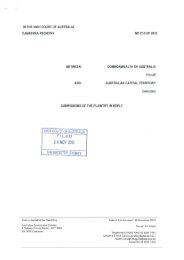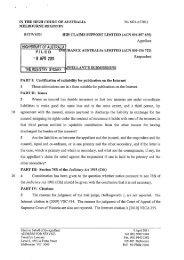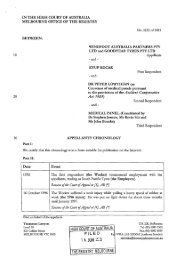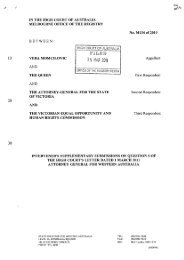Written submissions - High Court of Australia
Written submissions - High Court of Australia
Written submissions - High Court of Australia
You also want an ePaper? Increase the reach of your titles
YUMPU automatically turns print PDFs into web optimized ePapers that Google loves.
12<br />
50. By way <strong>of</strong> summary, to the extent that participation was mentioned at all, the oral<br />
summing up (and the reasoning <strong>of</strong> the <strong>Court</strong> below) tended to conflate involvement<br />
with participation. The trial judge's passing references to participation were thus apt to<br />
confuse the jury rather than to cure in some way the omission to refer to the element <strong>of</strong><br />
participation in the summing up and written redirection.<br />
51. Even if the passing references in the oral summing up would otherwise have been<br />
sufficient, the subsequent prominence given to a 'list' <strong>of</strong> the elements in the written<br />
redirection, which list did not include 'participation' as an element, rendered the trial<br />
judge's directions defective.<br />
10 52. The problem was compounded when the written redirection used the word participant<br />
to describe persons who were parties to the relevant agreement or plan. In this way,<br />
the written redirection would have led the jury into error in that it suggested that to the<br />
extent that they had gleaned from the summing up that it was necessary to consider<br />
'participation', they would have understood from the written redirection that it was<br />
sufficient to make out participation that the accused was a party to the agreement or<br />
plan.<br />
53. While, as a general proposition, a written redirection should be read against the<br />
background <strong>of</strong> the oral summing up (rather than be afforded primacy over the oral<br />
summing up), it is significant here that:<br />
20 53.1. the written direction was in the nature <strong>of</strong> a written redirection to a jury in<br />
response to a question indicating some degree <strong>of</strong> uncertainty as to the legal<br />
elements they were required to consider, as opposed to an aide memoire<br />
provided to the jury at the outset for them to consider while listening to the oral<br />
summing up (R v McKechnie (1992) 94 Cr App R 51 at [63]) and hence in<br />
circumstances where the relationship between the written direction and the<br />
summing up will be clear;<br />
30<br />
53.2. the practical reality <strong>of</strong> the provision <strong>of</strong> a written redirection is a tendency to<br />
assume undue prominence as something akin to a checklist, or a short cut or<br />
"answer" to the case - not least because a written summary becomes a<br />
permanent record which may be before the jury for hours. 5 2 This serves not<br />
only to enhance the significance <strong>of</strong> errors in a written direction, but also to<br />
52<br />
R v Muir [2009] SASC 94 at [40]-[42] per Sulan J, at [68]-[69] per Vanstone J, applying Duggan J's earlier<br />
observations to this effect in R v Tulisi (2008) 258 LSJS 428; [2008] SASC 306 at [55]; R v M [2000]1 WLR 421<br />
at 433-434; Hurst v Tasmania [2011] TASCCA 12 at [21].
















